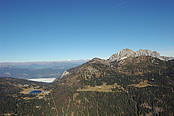Small Rodents
Marmot (Marmota marmota)
Habitat: a rodent that is widespread on the Alps, the Carpathians and the Altai.
Identification: the marmot is 60-70 cm long, including approximately 10 cm of tail, it body is robust and stout, with a thick fur; it has a large head; top cleft lip, with long whiskers; it incisive teeth are very curved and white in the young, yellow in the adults; short and strong legs, with claws for digging. These animals are diurnal.
Reproduction: they are gregarious animals; they live in small groups at an altitude of between 1500 and 3000 m and dig their dens at 3-4 m underground; they hibernate (which lasts from 6 to 8 months).
Food: they mainly feed on plants and perfumed herbs.
Wild Mouse (Apodemus sylvaticus)
Habitat: it lives in the woods and open places. It is common in Europe and also in Italy.
Identification: it is 8 -11 cm in length with a tail of the same length, it has a brown-grey coat and has an agile body, pointed snout, long whiskers and long tail; its incisive teeth protrude from the top lip.
Reproduction: it is a very prolific animal and the female gives birth up to six times per year, with anything up to ten mice at a time.
Food: it is omnivorous.
Squirrel (Sciurus vulgaris)
Habitat: it is a rodent that is widespread in Europe and Asia up to northern China. It lives on trees in thick woods, where it builds its nest in summer, gathering supplies for the winter season. It does not hibernate.
Identification: it is about 45 cm in length, 20 of which is tail, it has an agile body with a reddish, sometimes grey, coat; its head is round, it has a short snout and large eyes; its limbs have five thin fingers with curved claws, suitable for climbing; its tail, which is bushy at the end, is usually erect.
Reproduction: the female has multiple births during the year.
Food: it feeds on seeds, dried fruit and insects' eggs.
European Hedgehog (Erinaceus europaeus)
Habitat: it is found throughout Europe. It lives preferably in the woods and hunts in the twilight or nocturnal hours.
Identification: it has a stout body, which is about 30 cm in length, with a pointed and wet snout, big eyes, short tail, feet with robust claws suitable for digging; the top part of the body is covered with many 2-3 cm long spines (up to 16,000) that are dark brown in colour with hints of white at the ends, which in case of danger become erect by a series of subcutaneous muscles.
Reproduction: in autumn it prepares a nest on the ground, using leaves which it rolls up in to hibernate during the winter months. Its offspring are born blind, with bare bellies, while on their backs they have thin white spines that will fall.
Food: it feeds on insects, worms, snails, small mammals, reptiles, eggs, berries, etc.
Squirrel Tailed Dormouse (Glis glis)
Habitat: it is widespread in Europe and it is very common in Italy; it lives in the woods and particularly beech woods; it is nocturnal.
Identification: mammal of the order of rodents (Family gliridi), it is 30 cm long, including its tail, which measures about 15 cm and is covered with thick long hairs; its has a grey or chestnut brown top coat and white on the bottom.
Reproduction: during winter it goes into a long hibernation and reproduction is thus dependent on this necessity.
Food: it mainly feeds on chestnuts, nuts, or nests and birds' eggs.







